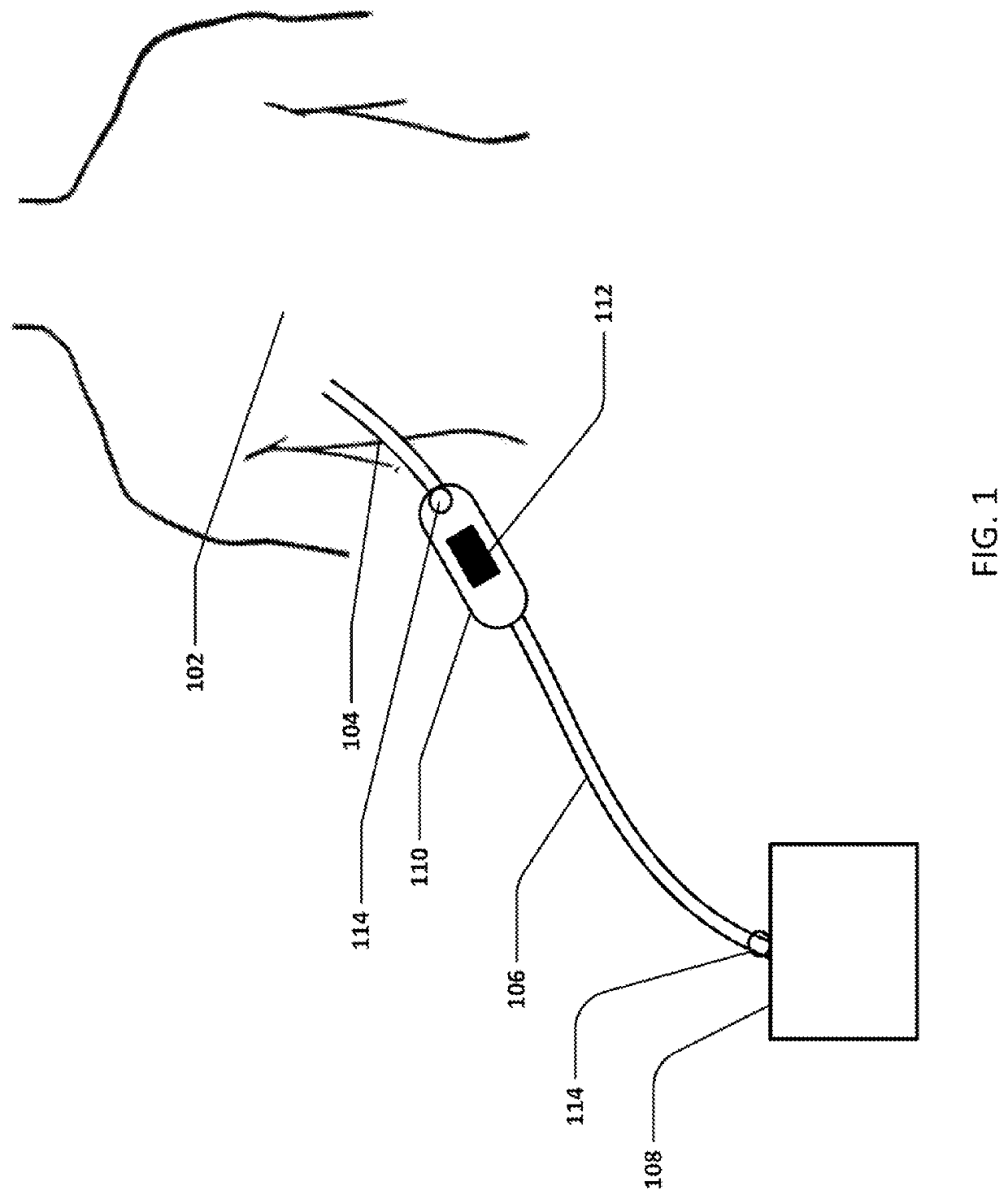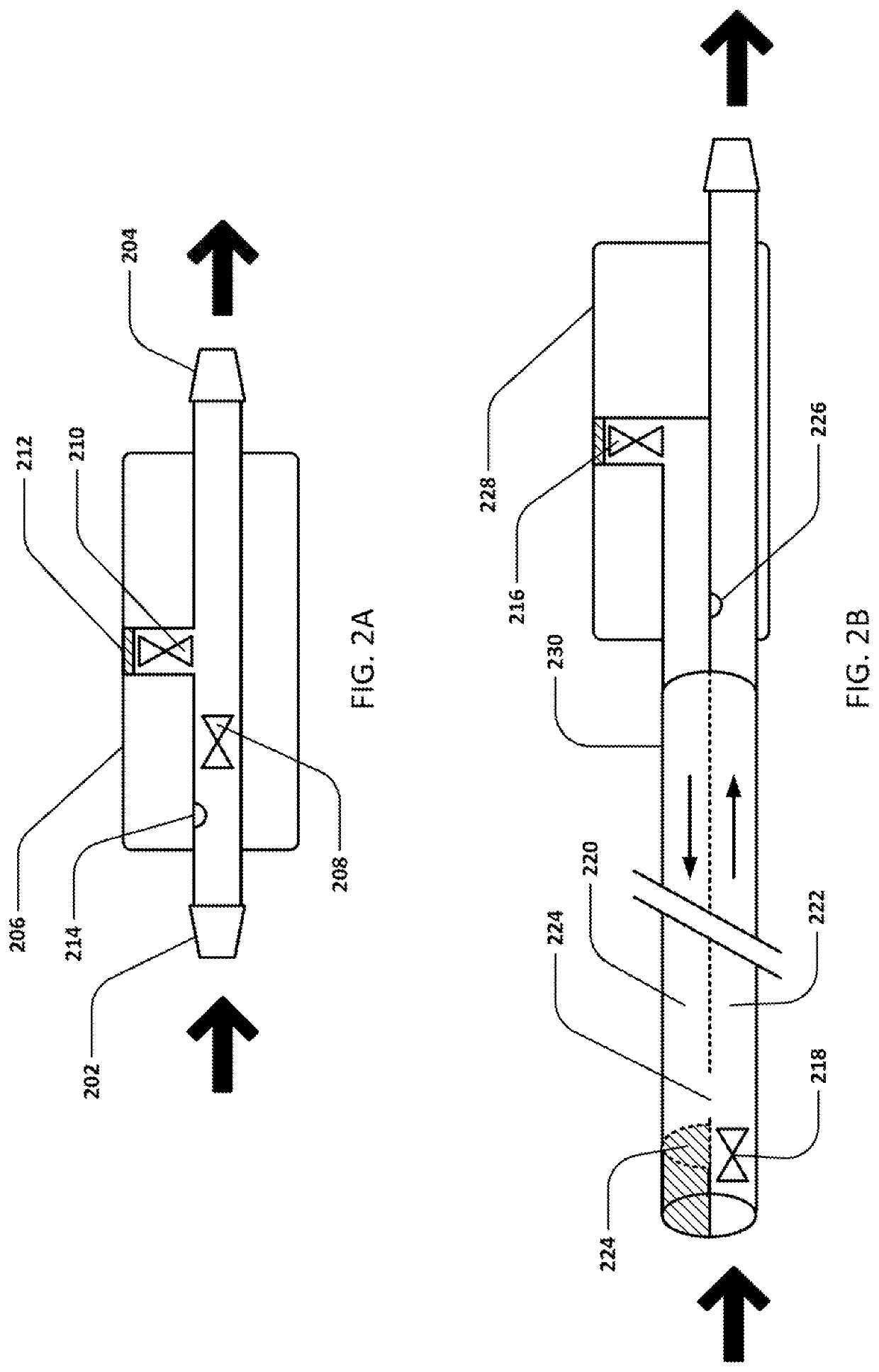[0007]A chest drainage system is needed which reduces or eliminates pooling of blood / liquid and / or clogging / clotting in the drainage tube.
[0008]One embodiment of the drainage system may generally comprise a suction device configured to generate a negative pressure, a first lumen body configured for insertion into a patient body, a second lumen body fluidly coupled to the suction device, a valve assembly fluidly coupled to the first lumen body and to the second lumen body, wherein the valve assembly includes at least a first valve having a closed configuration where the negative pressure generated by the suction device is maintained within the second lumen body, and the first valve further having an open configuration where the negative pressure draws air from an environment and through the second lumen body, a pressure sensor in communication with the first lumen body, and a controller in communication with the pressure sensor, wherein the controller is programmed to sense for a decrease in the negative pressure indicative of an obstruction within the second lumen body, wherein the controller is further programmed to actuate the first valve into the open configuration upon sensing the decrease to clear the obstruction. In another embodiment, the valve may have certain mechanical characteristics, including but not limited to crack pressure, such that it automatically open when the negative pressure decreases a certain amount, eliminating the need for the pressure sensor and controller.
[0009]Another embodiment of the drainage system may generally comprise a suction device configured to generate a negative pressure, a first lumen body configured for insertion into a patient body, a second lumen body fluidly coupled to the suction device, a valve assembly fluidly coupled to the first lumen body and to the second lumen body, wherein the valve assembly includes at least a first valve having a closed configuration where the negative pressure generated by the suction device is maintained within the second lumen body, and the first valve further having an open configuration where the negative pressure draws air from an environment and through the first lumen body, a pressure sensor in communication with the first lumen body, and a controller in communication with the pressure sensor, wherein the controller is programmed to sense for a decrease in the negative pressure indicative of an obstruction within the first lumen body, wherein the controller is further programmed to actuate the first valve into the open configuration upon sensing the decrease to clear the obstruction. In another embodiment, the valve may have certain mechanical characteristics, including but not limited to crack pressure, such that it automatically open when a certain pressure differential exists between the first and second lumen bodies, eliminating the need for the pressure sensor and controller.
[0010]In one exemplary method of use, the method for draining a body lumen ma generally comprise applying a negative pressure to a first lumen body inserted into a patient body, drawing a fluid from the patient body via the first lumen body and through a second lumen body in fluid communication with the first lumen body, monitoring via a pressure sensor for a decrease in the negative pressure as indicative of an obstruction within the second body lumen, actuating a valve assembly coupled to the first lumen body and to the second lumen body upon detecting the decrease such that at least a first valve in the valve assembly actuates from a closed configuration, where the negative pressure is maintained within the second lumen body, and into an open configuration, where the negative pressure draws air from an environment and through the second lumen body, and clearing an obstruction from the second lumen body via the air introduced into the second lumen body. In another exemplary method of use, the valve may automatically open when the negative pressure decreases by a certain amount, eliminating the need to monitor pressure and actuate the valve.
[0011]In another exemplary method of use, the method for draining a body lumen may generally comprise applying a negative pressure to a first lumen body inserted into a patient body, drawing a fluid from the patient body via the first lumen body and through a second lumen body in fluid communication with the first lumen body, monitoring via a pressure sensor for a decrease in the negative pressure as indicative of an obstruction within the first body lumen, actuating a valve assembly coupled to the first lumen body and to the second lumen body upon detecting the decrease such that at least a first valve in the valve assembly actuates from a closed configuration, where the negative pressure is maintained within the second lumen body, and into an open configuration, where the negative pressure draws air from an environment and through the first lumen body, and clearing an obstruction from the first lumen body via the air introduced into the first lumen body. In another exemplary method of use, the valve may automatically open when a pressure differential exists between the first and second lumen bodies eliminating the need to monitor pressure and actuate the valve.
 Login to View More
Login to View More  Login to View More
Login to View More 


